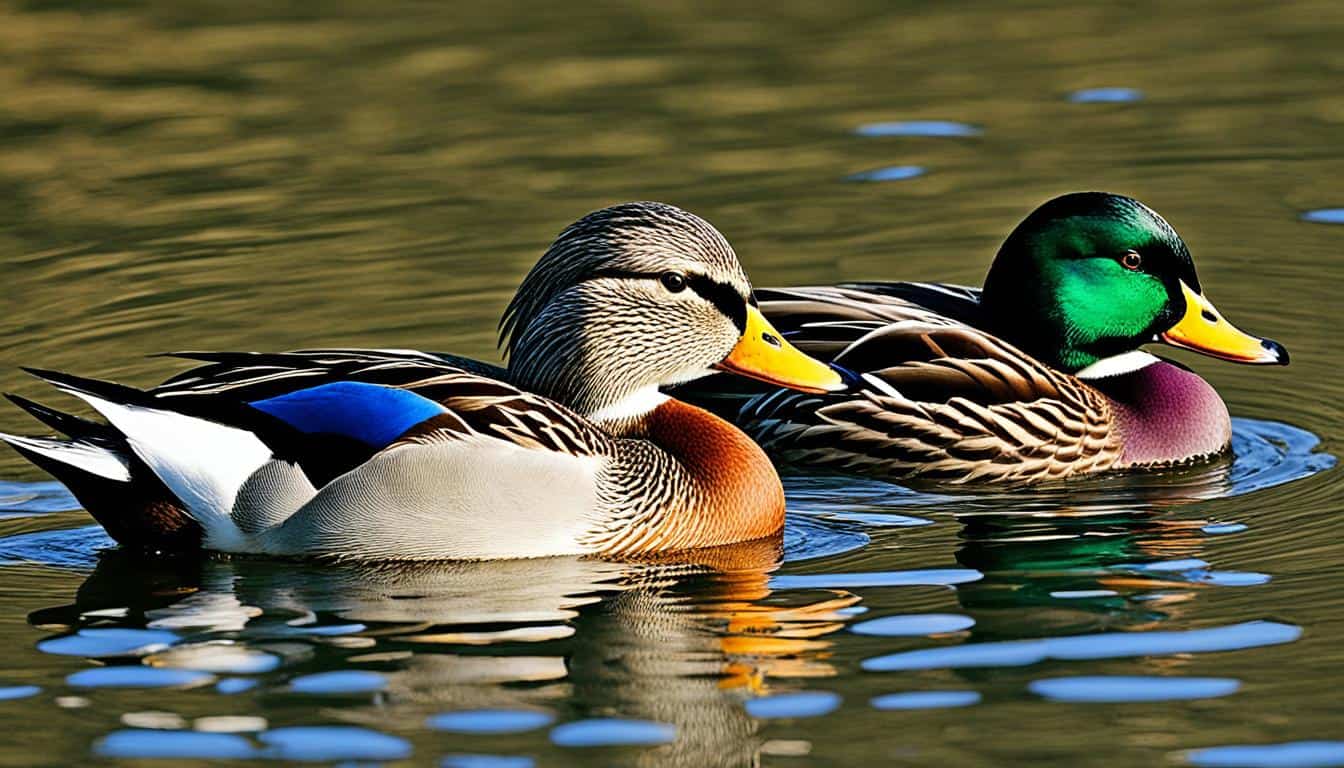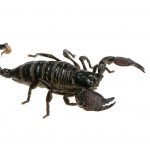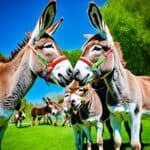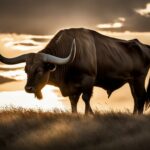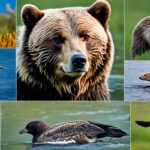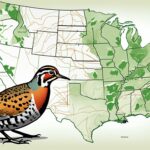Ever wonder how to tell the many duck species apart across America’s waters? It’s not that hard. Look for key things like colors, bill shapes, and where they like to hang out. You’ll become skilled in no time by paying attention to these details.
When watching ducks, bring binoculars and field guides. They make bird-watching more fun. Ducks such as Mallards, Northern Shovelers, Gadwalls, and American Wigeons have unique features. The colorful Wood Duck is also easy to spot. Explore the world of North American ducks. You’ll find amazing variety right in your area.
Introduction to Duck Species Identification
It’s essential for bird lovers and those who want to protect nature to know duck species in the United States. Identifying ducks adds joy to birdwatching and helps with important research. To tell duck species apart, learn about where they live and what they do.
Why Identify Duck Species?
Knowing the types of ducks in America makes bird watching more exciting. It also helps collect data for science. This data is crucial for saving duck species in the U.S.
It ensures they are protected for the future.
Understanding Duck Habitats
Ducks live in many places, from wetlands to coastal areas. It’s key to know these places to find and recognize duck types. Some ducks are only in certain regions. Knowing their favorite places helps with identifying them. For example, some like quiet ponds, others the lively coasts.
It’s also good to know their flying paths. This way, you can see different ducks throughout the year.
| Habitat Type | Common Species Found | Behavioral Traits |
|---|---|---|
| Marshy Wetlands | Mallard, Northern Shoveler | Surface Feeding, Dabbling |
| Expansive Lakes | Gadwall, American Wigeon | Surface Skimming, Grazing on Aquatic Plants |
| Coastal Regions | Redhead, Canvasback | Diving, Pursuit of Aquatic Prey |
By knowing their homes and habits, you can spot different species. This helps us enjoy and protect the variety of ducks in the U.S.
Common Techniques for Duck Identification
Identifying ducks in the USA relies heavily on the right techniques. It’s important to have the correct tools and know what to look for. This helps you spot the differences between North American duck species.
Observation Tools and Gear
Using the right tools is essential in duck identification. Binoculars and scopes help pinpoint important features from afar. Also, make sure you have the right gear. Waterproof boots and tough clothes let you watch ducks in any weather or place.
Field Marks and Distinguishing Features
Learn about the unique marks and features of North American duck species. Notice the shining feathers on birds like the male Mallard and Northern Shoveler. Also, pay attention to their bills. Each duck has a different-shaped bill. Knowing these details makes it easier to identify ducks accurately.
“The behavior of ducks, including foraging methods and flight patterns, also provides clues for identification.”
Being patient and persistent is crucial in duck identification. Watch how ducks act in their natural setting. Their behavior and interactions are key. By carefully observing ducks, you improve your chances of recognizing them correctly.
Behavior Patterns of North American Duck Species
The behavior patterns of North American ducks help us tell one type from another. For example, by watching how they feed, you can spot the differences. Dabbling ducks, such as mallards, tip over in the water to eat. Diving ducks, like scaup, dive completely under to find food.
Duck behavior in the sky is also key to telling them apart. Dabbling ducks launch straight from water surfaces. Diving ducks need a bit of a runway before they can fly. Understanding these flying habits makes duck ID much easier.
Each type of duck has its own special actions and features. Watching them closely can make you better at birdwatching. It also shows the amazing variety of ducks and other waterfowl in North America.
Visual Characteristics: Plumage and Coloration
Ducks in the USA are easy to spot because of their unique looks. These birds show clear differences between males and females. This includes changes in colors all year round.
Male vs Female Duck Differences
Male ducks, or drakes, have bright and unique feathers to attract females. Female ducks, on the other hand, have duller feathers to stay hidden while nesting. Knowing these color differences helps when identifying ducks in the USA and North American duck species.
Seasonal Plumage Changes
Duck feathers also change with the seasons. Males brighten up for mating, then go back to dull colors afterward. This pattern can be observed through the year. It aids in identifying ducks in the USA and in seeing the wide range of North American duck species.
Size and Shape: Key Physical Features
Identifying duck species relies heavily on their size and shapes. The features like the bill and body tell us a lot. They guide us in recognizing duck types and what they do in nature.
Bill Shape and Size
The bill is a key part in spotting different duck kinds. The Northern Shoveler, for example, has a bill shaped like a shovel. This shape helps it look for food in shallow waters. Seeing this bill makes recognizing them easier in the American duck species guide. Some ducks that dive have sharp bills that help them dive better.
Body Size and Shape
Ducks also have different body shapes and sizes. This is very noticeable between diving and dabbling ducks. Diving ducks look more streamlined, making them better underwater. Dabbling ducks, however, have shapes that help them float well on water. Knowing about these differences helps in spotting duck types. It also tells us about their habits and where they like to be.
Identifying Dabbling Ducks
Learning to spot dabbling ducks is key in the American duck species guide. They often stay in shallow spots like marshes and ponds. These ducks feed by reaching into the water from the surface rather than diving.
Dabbling ducks, like the Mallard and the American Wigeon, quickly take flight from the water. They also have a wide range of colors and patterns in their feathers.
Watching their natural actions is crucial for spotting dabbling ducks. These ducks are experts at flying off water. Plumage patterns and colors are big hints for telling duck species apart.
| Species | Characteristics | Habitat |
|---|---|---|
| Mallard | Iridescent green head, chestnut-brown chest | Ponds, lakes, marshes |
| American Wigeon | White forehead, green eye patch | Wetlands, shallow lakes |
| Northern Shoveler | Spatula-shaped bill, colorful plumage | Marshes, ponds |
Studying the American duck species guide means looking closely at dabbling ducks’ habitat and habits. This helps you not just identify different ducks but appreciate their beauty and behavior more.
Identifying Diving Ducks
Diving ducks are a big group found in the United States. They include birds like Canvasbacks, Redheads, and Ring-necked Ducks. These ducks have special ways to find food deep under the water. They need more space to fly because they’re heavier and shaped differently.
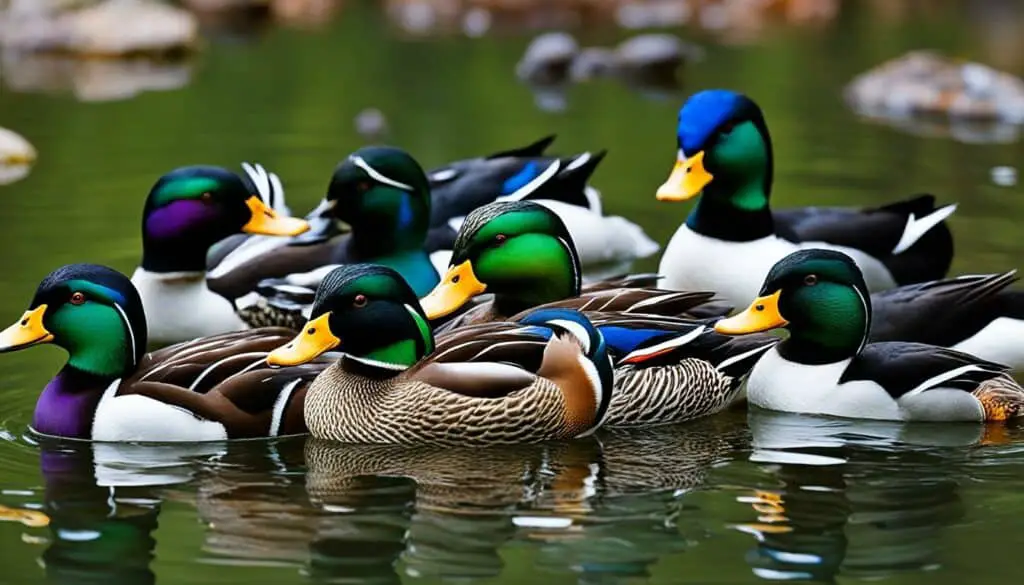
Spotting diving ducks is easier near big, deep waters. They have big feet and short wings. This helps them dive and swim really well. Knowing about these features helps us recognize them and see their important roles in nature.
| Diving Duck Species | Key Identifiers | Preferred Habitat |
|---|---|---|
| Canvasback | Sloping forehead, reddish head | Deep lakes, marshes |
| Redhead | Round head, blue-gray bill | Larger ponds, lakes |
| Ring-necked Duck | Peaked head, white ring around the bill | Freshwater ponds, coastal bays |
Regional Variations in Duck Species
Knowing about regional duck species variations in the U.S. can really help you identify ducks accurately. The Pacific Flyway and the Atlantic Flyway are very important migration paths. They see a lot of different types of ducks, each suited for the weather and places they travel through.
Ducks in the Pacific Flyway
The Pacific Flyway is a big route for ducks. It influences which ducks you’ll see, based on the kinds of places they like. Ducks like Northern Pintails and American Wigeons are often found here. Places with lots of water and mild weather make it a good home for many ducks.
It’s important to know what places and when ducks migrate through here. This helps a lot in telling the different duck species apart.
Ducks in the Atlantic Flyway
The Eastern coast is covered by the Atlantic Flyway, showing off very different duck homes. Places from cold tundras in the north to warm marshes in the south are home to ducks like Black Ducks and Blue-winged Teals. Marshes, estuaries, and the sea are where you’ll see these ducks the most.
Knowing where these ducks like to live and what makes them different boosts your ability to figure out what kind of ducks they are. It shows how important it is to understand the local environment for spotting ducks.
Using Behavior to Identify Ducks in the Field
Watching ducks’ behavior makes identifying them easier. Each duck type has its own way of acting. We can look at how they feed and fly.
Feeding Behavior: Dabbling vs Diving
Knowing how ducks feed helps tell them apart. Dabblers, like the Mallard, tip forward to feed in shallow water. You might often see their tails in the air. Diving ducks, on the other hand, like the Canvasback, dive below completely to get food. Duck feeding behavior is a big clue to what type you’re seeing.
Flight Patterns and Wing Beats
How ducks fly can also shed light on their type. Dabblers take off quickly with strong, fast wing beats. Diving ducks need more room and start by running on the water. They have deep, powerful wing beats. This detail helps when you’re watching them fly.
| Behavior Trait | Dabbling Ducks | Diving Ducks |
|---|---|---|
| Feeding | Tips forward, stays near surface | Submerges fully, feeds underwater |
| Flight Take-off | Immediate, rapid take-off | Running start on water surface |
| Wing Beats | Strong, rapid | Powerful, deeper |
Popular Duck Species to Watch For
Knowing how to spot popular duck types helps bird watchers. Here, I’ll show you three ducks and what makes them stand out.
Mallard
The Mallard is very easy to spot in North America. Males have bright, iridescent green heads, white neck rings, and chestnut-brown chests. On the other hand, females’ mottled brown looks make them unique among other ducks.
American Black Duck
It’s easy to mistake American Black Ducks for Mallard females. However, they have a few key differences. The American Black Duck is darker with a more even coloring and a lighter face. It also features a dark eye stripe. Their bill is usually green-yellow, unlike the Mallard’s orange and black one.
Wood Duck
The Wood Duck is stunningly colorful. Males are striking with their iridescent chestnut and green, alongside white, and a unique crest. The females, though more subtle, also have unique features. These include a white eye-ring and beautiful, but less dramatic, markings.
| Species | Key Characteristics | Comparison Points |
|---|---|---|
| Mallard | Iridescent green head (male), mottled brown (female) | White neck ring, chestnut-brown chest |
| American Black Duck | Darker plumage, lighter face with dark eye stripe | Similar to female Mallard, green-yellow bill |
| Wood Duck | Elaborate, colorful markings (male), white eye-ring (female) | Crested head, iridescent feathers |
How do you identify different species of ducks in the USA?
Being able to tell different species of ducks apart is crucial for those who love birds and want to protect them. Paying attention to where they live, like in marshes or near the sea, is a big part of figuring out which duck is which. You should also notice their colors and the shape of their bills. Field guides and binoculars are great for noticing these details.
Each duck has special looks that make them stand out. For example, the Mallard is known for its shiny green head. The Northern Shoveler has a bill shaped like a spoon. Knowing these special features helps you enjoy watching ducks more.
How ducks act is another key. Gadwall ducks, which like to dabble, tip their bottoms up when they look for food. On the other hand, ducks like the Redhead go completely under to find their meals. Watching how ducks feed and interact gives you clues to their kind.
To get better at telling ducks apart, use field guides, websites, and birding apps. These resources give you lots of info on how ducks look, sound, and where they can be found. They are very handy for both new and experienced bird watchers. They also help you double-check which ducks you’ve seen and make bird watching more fun.
| Bird Name | Key Field Mark | Habitat |
|---|---|---|
| Mallard | Iridescent Green Head | Lakes and Ponds |
| Northern Shoveler | Spatula-like Bill | Marshes and Wetlands |
| Gadwall | Subtle Plumage | Shallow Waters |
| Redhead | Cinnamon-colored Head | Large, Deep Water Bodies |
By learning from both what ducks look like and how they act, you become a true duck expert. This not only makes you happy but also helps with saving these beautiful birds and their homes.
Field Guide and Resources for Duck Identification
A duck species identification guide is key for bird watchers, whether they’re just starting or seasoned. These guides describe the looks, actions, and homes of duck types, making it easier to spot. They often include pictures or drawings to help tell similar ducks apart.
You can also find lots of online duck identification resources to make birdwatching more fun. Websites and databases offer fresh info, like where ducks live and what their sounds are. Using these tools gives you the latest details for better, quicker identification.
Birding apps are a great way to track and spot ducks. They offer live location updates and tips on the best birdwatching areas. Mixing these apps with field guides creates a rich learning experience. This blend of printed and online duck identification resources will take your birdwatching to the next level.
FAQ
How do you identify different species of ducks in the USA?
To tell ducks apart in the USA, we look at their colors, bill shapes, and how they act. We use things like binoculars and field guides to see them better. These tools make spotting different kinds of ducks easier and more fun.
Why identify duck species?
Knowing which duck is which lets people who love birds and those who study them enjoy their hobby more. It adds to the joy of bird watching. Plus, it helps gather important information about these water birds.
What are some common habitats for ducks in the USA?
You can see ducks in many places like wetlands, lakes, and the coasts. It’s important to know where they live to find and name them.
What observation tools and gear should I use to identify ducks?
It’s good to have binoculars, maybe a scope, and guides for a clear view. Also, wear clothing and shoes that are right for the weather and terrain. This makes watching birds a lot more fun and comfortable.
What are key field marks and distinguishing features for duck identification?
Special marks like shiny feathers, interesting bills, and features like a Mallard’s green head or a Shoveler’s unique bill help know different ducks.
How do behavior patterns help in identifying duck species?
Watching how ducks eat or fly tells us what they might be. Dabbling ducks feed differently from diving ducks. This is a big hint.
What are the visual characteristics of duck plumage and coloration?
Male ducks usually have lively colors than females. They wear brighter shades in mating times. Duck colors can change with the season. Knowing this helps identify them accurately.
How do size and shape help in identifying ducks?
Size and body shape tell us a lot. For instance, a Northern Shoveler’s big, flat bill is very different from what a diving duck looks like.
How can I identify dabbling ducks?
Dabbling ducks like the Mallard and Wigeon prefer areas where the water is not too deep. These ducks tilt their head into the water to eat. They can fly away fast with their strong wings.
How can I identify diving ducks?
Diving ducks go all the way under the water to find food. They need more room to take off and like deep places. Their small, stout bodies and big feet are good signs it’s a diving duck.
What are the regional variations in duck species in the USA?
Duck species and their numbers change by region and season. Places like the Pacific and Atlantic Flyways host ducks that suit their specific home. The weather and habitats also affect what ducks you might see.
How does behavior help in identifying ducks in the field?
How ducks move and eat can narrow down who they are. Paying attention to how they fly can tell you if they’re a dabbler or a diver.
What are some popular duck species to watch for?
Look out for the Mallard, which is well-known for its green head. The American Black Duck stands out with its rich, dark colors. The Wood Duck draws eyes with its fancy designs and bright colors.
What resources are useful for duck identification?
Field guides, online tools, and apps for birding are great helps. They offer close-ups, info, and tips. These make spotting and knowing ducks more interesting and easier.

